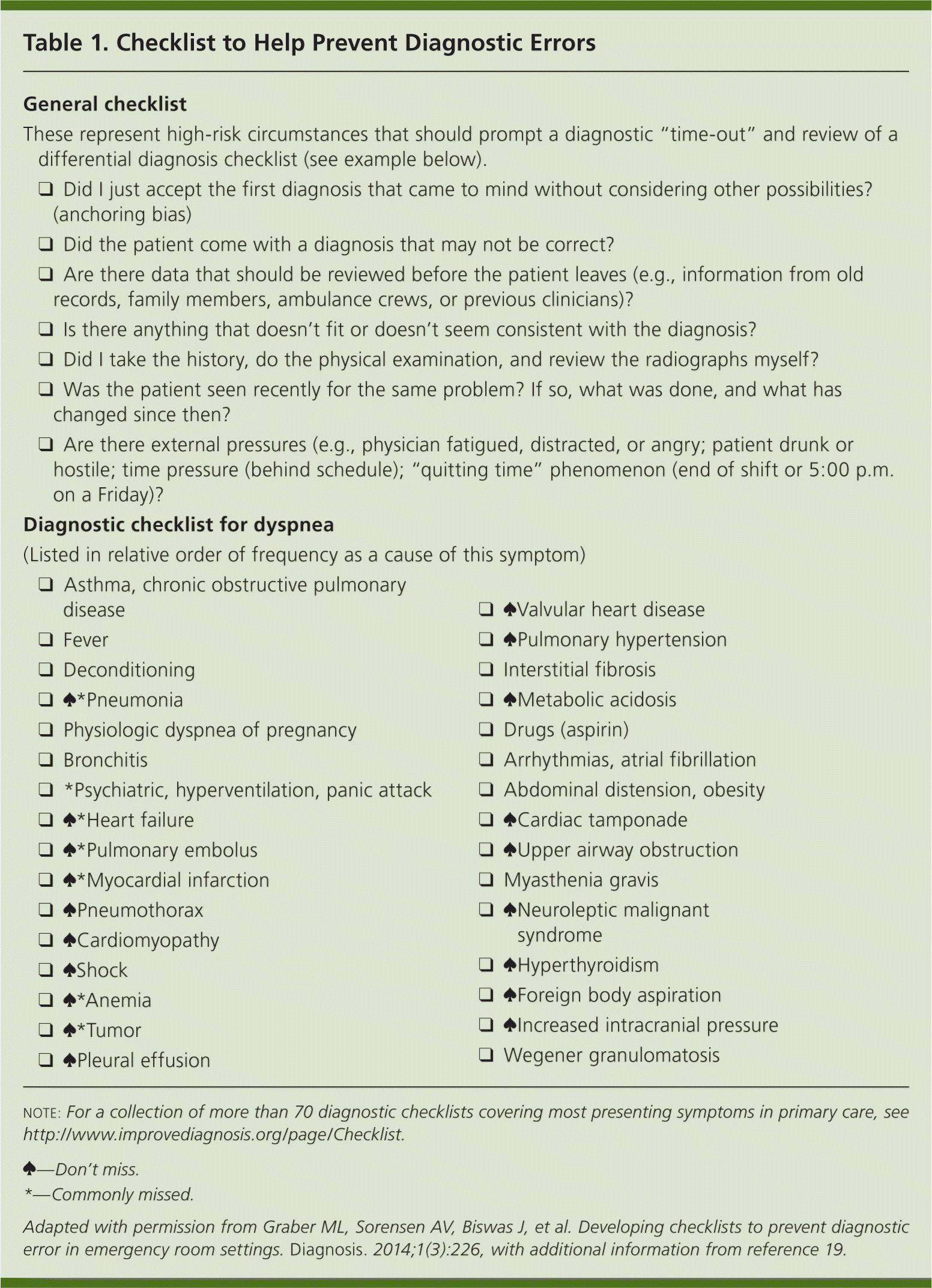
Am Fam Physician. 2016;94(6):426-432
Author disclosure: No relevant financial affiliations.
Diagnosis is the most difficult thing we do. We usually do it well, but we are not perfect. Diagnostic errors are important because they are common,1,2 and they harm patients and physicians.3,4 Until recently, physicians and hospitals have ignored diagnostic errors, partly because they are not like other kinds of medical errors. They are more difficult to define and detect, more difficult to prevent, and more difficult to discuss, given that most diagnostic errors involve a personal, cognitive error rather than a systematic problem that is less likely to be tied to individual failings. However, a recent report from the Institute of Medicine (IOM) has brought a bright light into this dark room.5
Most diagnostic errors are caused by the physician's cognitive biases and failed heuristics (mental shortcuts), such as anchoring bias (overly relying on the initial information received or initial diagnosis considered), context errors, or premature closure of the diagnostic process.6–8 More than 40 of these biases have been described,9,10 but most lead to a single pathway in which the physician fails to generate an adequate differential diagnosis or to even consider the correct diagnosis as a possibility. The single most common reason for a diagnostic error is simply, “I just didn't think of it.”11
We have a fair amount of evidence on the causes of diagnostic errors6,7,12 but much less evidence on how to prevent them.13–15 Despite this lack of evidence, we have some preliminary experience with interventions that have shown promise, at least anecdotally.16–19 A key suggestion from the IOM report is to involve the patient as a partner in the diagnostic process. First, frankly discuss any diagnostic uncertainty, and make sure the patient knows when and how to contact you if symptoms evolve or do not resolve as expected. Next, take advantage of second opinions from your family medicine colleagues or consultants. Fresh eyes can potentially catch many mistakes.20
A third approach combines elements of these first two suggestions: Get a second opinion from yourself by using a diagnostic checklist and constructing an appropriate differential diagnosis. Even when the diagnosis seems straightforward, we advise that physicians take a “diagnostic time-out” to step back and review a checklist that may suggest other possibilities—an approach that would tend to counteract almost all of the common cognitive slips.
Online aids for differential diagnosis are available and can improve the reliability of diagnosis,21 but we recommend a simple two-part checklist developed specifically for family medicine. The first part prompts the physician to review the most troublesome cognitive failings found by investigators who asked physicians to describe their own errors and what they thought caused them.6–8,16 The second part is a clinically oriented differential diagnosis designed to force consideration of all reasonable causes for the patient's presenting symptom (Table 1).16,19

| General checklist |
| These represent high-risk circumstances that should prompt a diagnostic “time-out” and review of a differential diagnosis checklist (see example below). |
|
| Diagnostic checklist for dyspnea |
(Listed in relative order of frequency as a cause of this symptom)
|
We recognize that busy physicians may not have time to take a time-out. However, the checklist can be reviewed in less than two minutes,17 and it is not needed for the large group of patients in whom diagnosis is not the primary issue, such as those returning for annual examinations or chronic disease follow-up. But there are other obstacles to using checklists besides time. Physicians often feel pressured to arrive at a diagnosis with little contemplation because this helps assure patients that they know what they are doing. The patient might lose confidence in a physician who pauses to think, particularly in one who refers to a checklist. However, we would have little confidence in an airline pilot who failed to review a preflight checklist, and patients have voiced understanding of this analogy in practice.18
In our experience, patients appreciate the extra thought and systematic approach prompted by the time-out. It provides visible and immediate evidence that they are being taken seriously. Of course, the physician could review the checklist outside the exam room or surreptitiously on the computer screen, but then this evidence of thoroughness would be lost. Additionally, patients often provide valuable additional history when the checklist is read aloud. What exactly should the physician say to maintain patient confidence? “Mary, this is what I think you have, and this is what I think we should do. But before you go, I just want to be sure we haven't missed anything, so I'm going to go through a checklist. After that, we need to get those labs and the x-ray we talked about.” (For video demonstration, see http://www.youtube.com/watch?v=uHpieuyP1w0.)
Checklists are no substitute for training and experience, but training and experience alone are not enough. Failing to consider the correct diagnosis, whether because of a simple oversight or a not-so-simple presentation, is the most common cause of diagnostic errors. In either case, a checklist has the potential to prevent this failure. As human beings, we are terrible at recognizing our own emotions and cognitive biases at the time these biases are doing their damage,22 and our level of confidence in a diagnosis correlates poorly with its accuracy.23 Gawande admitted that we do not like checklists because they can be painstaking and embarrassing, and are not often used by those we aspire to be.24 However, they may lead to a more reliable and safe diagnosis, just as they have led to more reliability and safety in the airline industry, operating room, and intensive care unit.25,26
Taking specific steps to make diagnosis more reliable is something we should all consider. We will never be perfect, but we owe it to our patients and our profession to improve.
